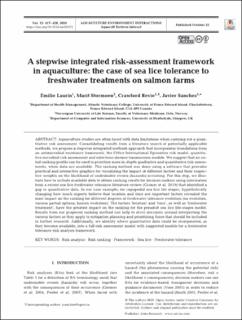| dc.contributor.author | Laurin, Emilie | |
| dc.contributor.author | Stormoen, Marit | |
| dc.contributor.author | Revie, Crawford W. | |
| dc.contributor.author | Javier, Sánchez-Hernández | |
| dc.date.accessioned | 2020-11-17T13:22:16Z | |
| dc.date.available | 2020-11-17T13:22:16Z | |
| dc.date.created | 2020-11-16T11:00:07Z | |
| dc.date.issued | 2020 | |
| dc.identifier.citation | Aquaculture Environment Interactions. 2020, 12 417-428. | en_US |
| dc.identifier.issn | 1869-215X | |
| dc.identifier.uri | https://hdl.handle.net/11250/2688274 | |
| dc.description.abstract | Aquaculture studies are often faced with data limitations when carrying out a quantitative risk assessment. Consolidating results from a literature search of potentially applicable methods, we propose a stepwise integrated methods approach that incorporates foundations from an antimicrobial resistance framework, the Office International Epizooties risk model, quantitative microbial risk assessment and infectious disease transmission models. We suggest that an initial ranking profile can be used to prioritize more in-depth qualitative and quantitative risk assessments, when data are available. The ranking method was done using a software that provides practical and interactive graphics for visualizing the impact of different factors and their respective weights on the likelihood of undesirable events (hazards) occurring. For this step, we illustrate how to include available data to obtain ranking results for decision makers using information from a recent sea lice freshwater tolerance literature review (Groner et al. 2019) that identified a gap in quantitative data. In our case example, for copepodid sea lice life stages, hypothetically changing how much experts believe that location and time are important factors revealed the most impact on the ranking for different degrees of freshwater tolerance evolution (no evolution, various partial options, known evolution). The factors ‘location’ and ‘time’, as well as ‘freshwater treatment’, have the greatest impact on the ranking for the preadult sea lice life-stages model. Results from our proposed ranking method can help to drive decisions around interpreting the various factors as they apply to mitigation planning and prioritizing those that should be included in further research. Additionally, we identify where quantitative data could be incorporated, as they become available, into a full risk assessment model with suggested models for a freshwater tolerance risk analysis framework. | en_US |
| dc.language.iso | eng | en_US |
| dc.rights | Attribution-NonCommercial-NoDerivatives 4.0 Internasjonal | * |
| dc.rights.uri | http://creativecommons.org/licenses/by-nc-nd/4.0/deed.no | * |
| dc.title | A stepwise integrated risk-assessment framework in aquaculture: the case of sea lice tolerance to freshwater treatments on salmon farms. | en_US |
| dc.type | Peer reviewed | en_US |
| dc.type | Journal article | en_US |
| dc.description.version | publishedVersion | en_US |
| dc.source.pagenumber | 417-428 | en_US |
| dc.source.volume | 12 | en_US |
| dc.source.journal | Aquaculture Environment Interactions | en_US |
| dc.identifier.doi | 10.3354/aei00373 | |
| dc.identifier.cristin | 1848251 | |
| dc.relation.project | Fiskeri- og havbruksnæringens forskningsfinansiering: 901438 | en_US |
| cristin.ispublished | true | |
| cristin.fulltext | original | |
| cristin.qualitycode | 1 | |

